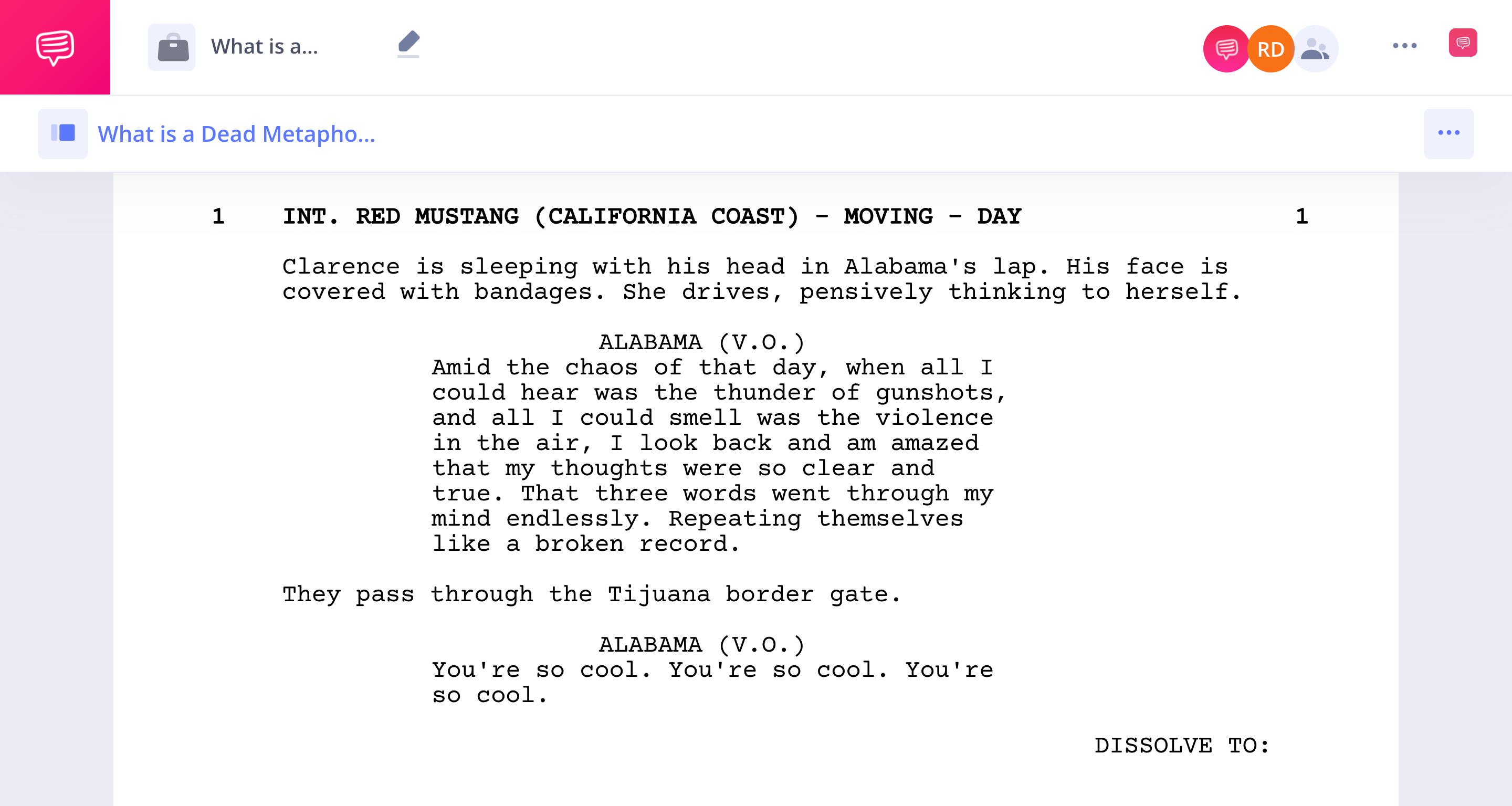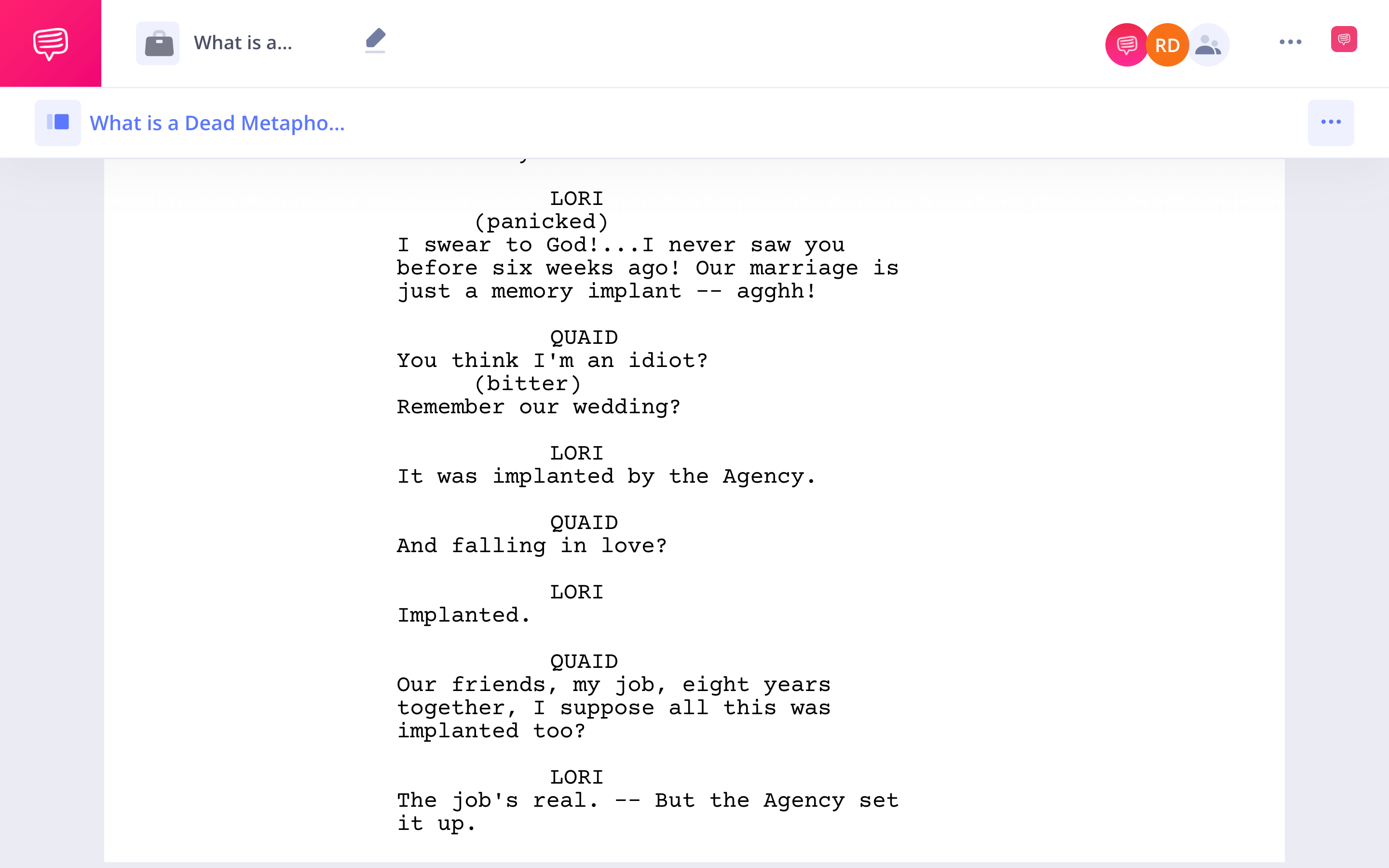Metaphors are an important part of any writer’s lexicon. At their best, metaphors can crystalize an image or meaning in just a few words. Sometimes, however, they’re not operating at their best. Some of the most maligned metaphors are called dead metaphors, and most writers avoid them. But what is a dead metaphor? And is there any time you may want to use one?
What is a Dead Metaphor?
First, let's define dead metaphor
Before we look at some dead metaphor examples and their merits (or lack thereof), let’s nail down a definition. Obviously, it is important to know what a standard metaphor is before you can identify a dead one.
A metaphor is type of figurative language that compares one thing to another. For example, "love is a battlefield" — this is not a literal comparison but means to borrow the qualities of one thing to characterize something else.
So, now, what is a dead metaphor?
DEAD METAPHOR DEFINITION
What is a dead metaphor?
A dead metaphor is a metaphor which has lost its meaning due to overuse. Otherwise called a "frozen metaphor," it is a type of linguistic cliché that sometimes overlaps with idioms. Writers will often avoid using this type of metaphor because of this. However, they can still be used for comedic purposes by calling attention to themselves.
Dead Metaphor Examples:
- Sleeping with the fishes
- Stick in the mud
- Head over heels
You’ve probably seen the above examples a million times. That’s inherent to the dead metaphor – they’re everywhere. But what makes them different from other types of metaphors?
WHAT IS A DEAD METAPHOR?
Differentiating metaphors
A dead metaphor is just one of many types of metaphors. As a reminder: a metaphor is a figure of speech which applies the attributes of a word or phrase to a subject in ways that are not literal.
Of course, all dead metaphors are metaphors (we’ll wait while you pick your jaw up off the floor), but not all metaphors are dead or dying metaphors. Some are alive and well. Here’s what separates dead metaphors from a few other types of metaphors and figurative language.
Dead Metaphors vs. Implied Metaphors
An implied metaphor is a metaphor which omits one of the two elements being figuratively compared. Okay– so what does that mean? Think of this line: “The lieutenant barked orders at his subordinates.” Here, the lieutenant is being compared to a dog, but “dog” isn’t explicitly named. Hence, implicit.
Some dead metaphors are implied metaphors, and vice versa. Take “Went belly up,” for example. This phrase is implicitly comparing a subject to a fish, so it’s an implied metaphor. But it’s also been used a million times, and no longer conjures that image when someone invokes it. So it’s a dead metaphor.

Implied metaphor example
Dead Metaphors vs. Mixed Metaphors
Dead metaphors and mixed metaphors are similar because they both are usually avoided by writers. A mixed metaphor, however, is a misuse of metaphoric language – it mixes two figurative phrases in a way which doesn’t logically make sense.
Here’s an example of a mixed metaphor: “He hit the chip on the old block.” Here, we’re mixing the phrases “He hit the nail on the head” and “he’s a chip off the old block” to create a phrase which makes no sense.
You may have noticed that the two phrases being mixed are in fact dead metaphors. That’s because mixed metaphors rely on dead metaphors to work. If they just combined two random metaphors, they would be gibberish (or rather, more gibberish than it already is).
Dead Metaphors vs. Idioms
An idiom is a term which has meaning that can’t be deduced based on its actual content. Instead, an idiom’s meaning comes from cultural context. For example, “it’s raining cats and dogs” makes no literal sense, but if you’ve grown up speaking American English, you know that it means it’s raining hard.
Dead metaphors and idioms, therefore, have a lot of overlap. Let’s take the sentence: “The road test was a piece of cake.” Here, we have a dead metaphor – the road test is being figuratively compared to a piece of cake, and it is a metaphor we’ve all heard a million times.
But the phrase “piece of cake” is also an idiom. Let’s take this collection of words on their face. Nothing about “piece of cake” in and of itself indicates that it means “easy.”
What is a Dead Metaphor?
When to avoid dead metaphors
By their very nature, dead metaphors are everywhere. So why do most writing teachers advise against them?
The answer is similar to why we avoid clichés. If your writing is filled with phrases that we’ve all heard a million times, then why should we be reading your writing? It’s not saying anything new.
Furthermore, a dead metaphor doesn’t convey as much information as a more unique turn of phrase. George Orwell, one of the greatest writers of the 20th century, succinctly summed up why dead metaphors can be a problem in his essay “Politics and the English Language,” a must-read for any writer:

“There is a huge dump of worn-out metaphors which have lost all evocative power and are merely used because they save people the trouble of inventing phrases for themselves […] Many of these are used without knowledge of their meaning [...] and incompatible metaphors are frequently mixed, a sure sign that the writer is not interested in what he is saying. Some metaphors now current have been twisted out of their original meaning without those who use them even being aware of the fact.”
— George Orwell
To Orwell, a dead metaphor is often indicative of lazy writing – never a good thing.

George Orwell, perhaps writing about dying metaphors
Let’s look at a dead metaphor example and see how we can improve it. Take the sentence, “Jason’s pastry shop went belly up.” Here, we’re using a dead metaphor to tell us that Jason’s store went out of business. "Belly up" is meant to describe a dead fish, which will often float upside down.
But what if we rewrote the sentence to look like this: “Jason’s pastry shop was a head-on car crash with no survivors.” Now we get a lot more information – not only is Jason’s store out of business, its demise was a disaster that affected a lot of people negatively.
Or we can rewrite the sentence with a different metaphor: “Jason’s pastry shop was a horse-and-buggy in a Model T world.” Here, we’re told that the pastry shop was out of date, a mismatch for the current moment.
We can go on bashing dead metaphors all day, but instead, let’s take a look at when they can be useful.
Related Posts
What is a dead metaphor?
Good dead metaphor examples
As with any writing advice, there are exceptions to the avoid-dead-metaphors rule. Dead metaphors are a part of our everyday speech, which means that they can be useful when writing… everyday speech.
When writing dialogue, you usually want your character’s voice to resemble how a person would talk, and people talk with dead metaphors.
Quentin Tarantino is a filmmaker lauded for his unique dialogue. But though it’s stylized, there’s still an element of reality in each of his characters’ voices. Read this voiceover from Tarantino’s script for True Romance, which we imported into StudioBinder’s screenwriting software.
See if you can spot the dead metaphor.
True Romance script • Dead metaphor examples
Alabama’s dialogue is simultaneously profound and folksy, true to her character’s background. Part of how Tarantino pulls this off is the use of a dead metaphor: “like a broken record.”
Watch how the scene turned out, wistful and stylized:
True Romance • Dead metaphor examples
A dead metaphor in dialogue can also tell us about a character. In Total Recall, writers Ronald Shusett, Dan O’Bannon and Gary Goldman use the dead metaphor “falling in love” to characterize their protagonist, Douglas Quaid. Take a look at the script:
Total Recall script • Dying metaphors examples
In this scene, Quaid is still naive to the reality of his situation. His life as he’s known it is a lie. The use of “falling in love” emphasizes his attachment to the fake, cookie-cutter life he was leading.
He’s listing all the life milestones of an everyday person — wedding, friends, jobs — and so talking like an everyday person only makes sense.
The innocence of the everyday line also serves as a fantastic juxtaposition to the action taking place in the scene. Watch it below:
Total Recall • Implanted Memories
Quaid has the woman he’s “fallen in love” with in a chokehold. Life comes at you quick.
But remember: even in dialogue, dead metaphors should be used sparingly. If a character’s speech is littered with clichés, the audience may tune out (but hey, maybe that’s the desired effect).
Dead metaphors are everywhere you look. Sometimes that’s good, sometimes it’s bad, and often, it’s somewhere in between.
Related Posts
Up Next
What is a Visual Metaphor?
Just because you now know what a dead metaphor is doesn’t mean you’re a metaphor expert – at least not yet. Learn about another crucial type of the figurative language technique in our comprehensive look at visual metaphors.


